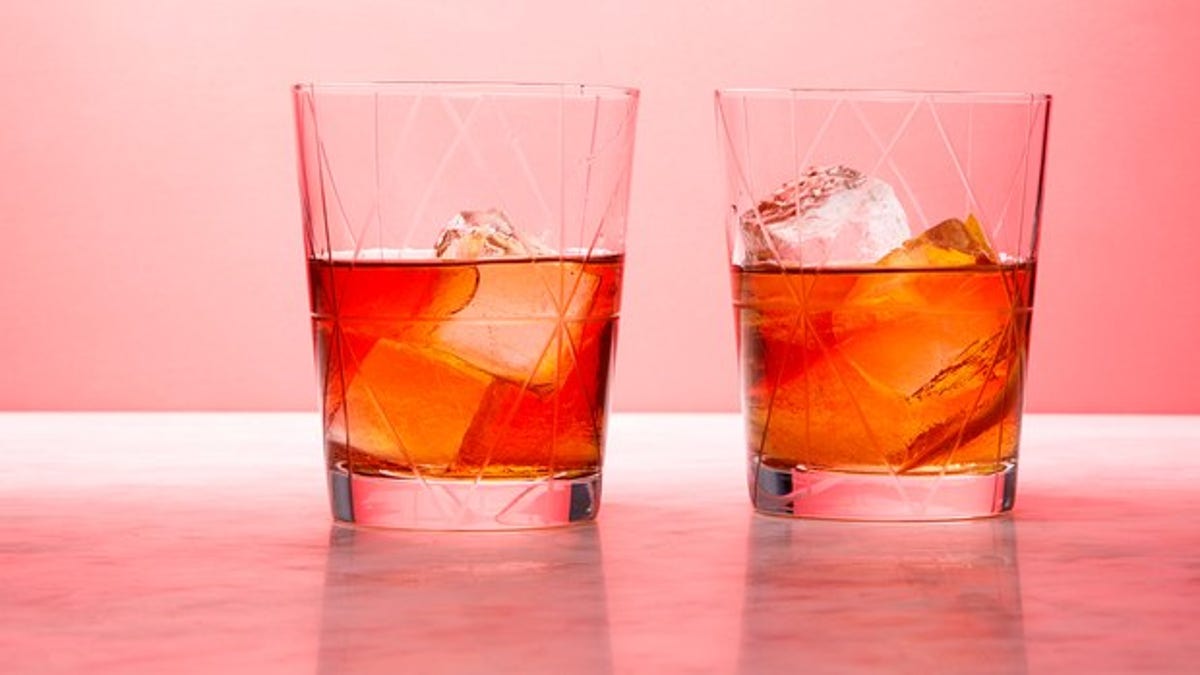
Big fancy ice cubes actually have a purpose in craft cocktails. (Chelsea Kyle, Food Styling by Anna Stockwell)
With the rise of fancy-cocktail bars has come an increased attention to all aspects of the drinking experience—the liquors and the recipes, sure, but also the ice cubes.
Or ice balls, or cylinders, or chips, or shards, depending on your tipple.
You'll notice one commonality among the different shapes, though: this stuff tends to be crystal-clear. Like, you could read the New Yorker through it.
Your ice cubes at home? Not so much. Regular tap water, frozen in an ice-cube tray, usually looks a little cloudy, the result of impurities and air bubbles that get pushed to the center of the cube as it freezes. Fancy-cocktail places spend piles of money on technology that avoids this problem—the preferred gadget is a Clinebell machine, which freezes ice from the bottom so the air bubbles are pushed to the top, where the water is circulated, so they dissipate.
This machine costs, well, a ton, and, uh, probably won't fit in your kitchen. But the home aficionado is not without de-clouding options, following this same general principle.
It all starts with the right cooler.
The most elaborate way to do this is to use a cooler. Pour some water in it and, presuming you've got an empty freezer handy, stick it in there. As Bon Appétit explained a while back, the ice will freeze from the top, pushing all the air bubbles to the bottom; the trick is to take the ice out of the cooler before the cloudy part freezes, or to chip it off afterward.
For an added artisanal touch, the ice is then broken apart with a sharp or heavy instrument, but you could also stick an ice cube tray in the bottom of the cooler for easier handling.
Don't have a lot of freezer space?
You can push some of the air out of that water ahead of time if you boil it, once or twice, before freezing. You can also get a head start if you use distilled, rather than tap, water. I tried this and other techniques at home recently, taking my advice from various corners of the internet and working at escalating levels of fussiness.
More from Epicurious
11 Ingredients You Should NEVER Refrigerate
12 Lightning-Fast Chicken Dinners to Make Now
14 Main Course-Worthy Vegetarian Salads
The Epic Hack to Peeling a Dozen Eggs in 104 Seconds
Boil, baby, boil.
Boiling tap water once. I brought water to a boil—regular, sweet, delicious New York tap water—and poured it into an ice cube tray. These ice cubes came out looking pretty much like regular ice cubes.
Boiling tap water twice. I boiled water once, left it alone for about a half hour, and then boiled it again. The ice cubes that resulted still had a little cloud in the center, but they were noticeably clearer elsewhere—you could see all the way through to the other side.
Boiling distilled water once. This, too, didn't make a whole lot of difference.
Boiling distilled water twice. Hark! The clearest ice yet. It wasn't crystal, but all the air had been consigned to a little cloud toward the bottom of the cube of ice, and the rest of it was beautifully translucent—something you could feel a little bit proud to serve to guests. All that was needed now was a glass of whiskey.
